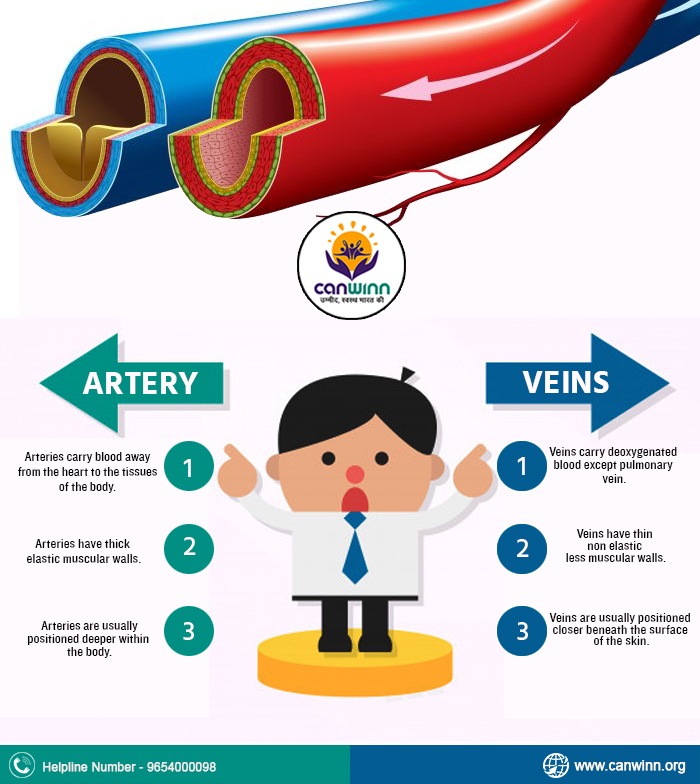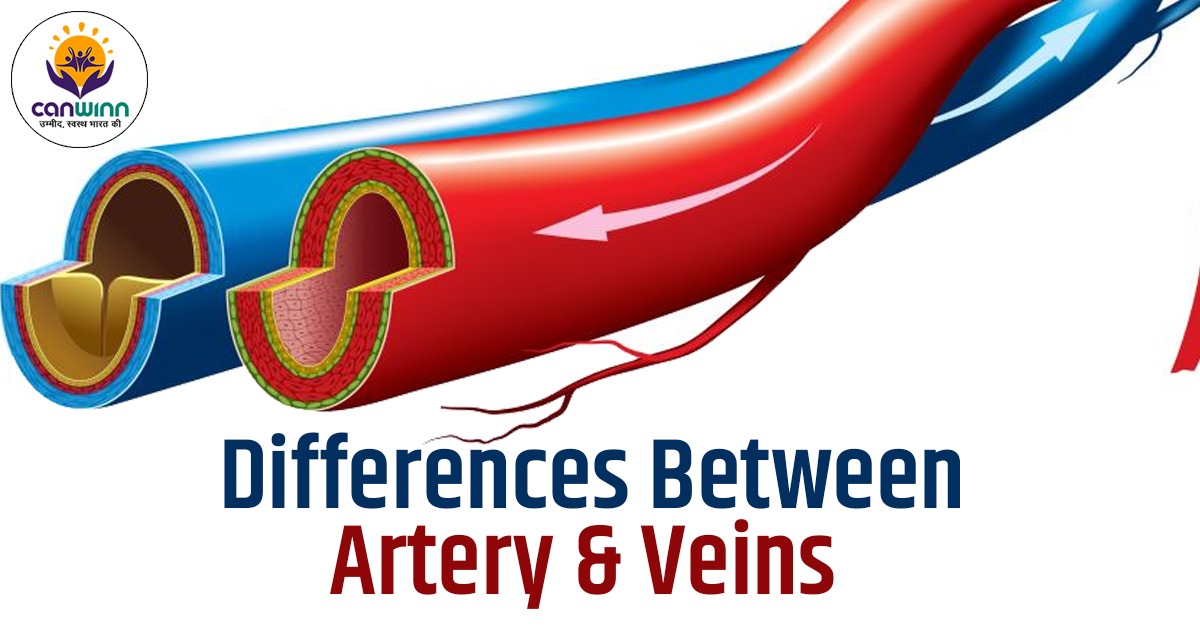As you all are aware of the fact that arteries and veins both are associated with the circulatory system of our body. Today, we will know the differences Between Artery & Veins.
What are Arteries?
According to human physiology, arteries are the type of blood vessels that works as delivering oxygenated blood and other nutrients from our heart with the tissues of our body.
In soft tubes, it is the muscular tube that consists of three layers.
The three layers are known as the media, the intima, and the adventitia. During the pumping action, these soft tissues deliver blood under the high pressure exerted by the heart.
The innermost layer of the wall of an artery is intima. This intima is also known as tunica intima. As this layer is the innermost layer, it is in direct contact with the flowing blood. While tunica media is the middle layer of the artery wall. It consists of elastic fibers and smooth muscles. At last, the outermost layer that covers the arteries is the Adventitia or Tunica Adventitia. This Adventitia is consisting of the connective tissue, the elastic fibers, and collagen.
Considered has the largest artery as arises from the left ventricle of the heart. This artery is known as an aorta. And aorta contains many small branches that are known as smaller arteries.
Moreover, these arteries hold various sub-branches called arterioles. And now these arterioles also hold sub-branches that are known as capillaries.
In order to regulate the fluctuating pressure during blood flow, the arteries and the arterioles possess more smooth muscles. The heart pumping is responsible for the pressure and it happens in two phases:
- the diastolic phase
- And the systolic phase.
Therefore, the heart’s resting period is known as the diastolic phase. It depicts the low blood pressure.
On the contrary, the heart’s increased pressure phase is known as the systolic phase. This phase forces the blood to the arteries.
At the moment when you check the pulse rate, the fluctuation of pressure can be recognized.
What is Vein?
The veins are known to carry the waste product and the deoxygenated blood. More clearly, the organs and tissues of our body use oxygen that is present in the blood to perform their function. In return to this, they produce waste products and carbon dioxide back to the blood. Both of these things are then carried by the veins. Therefore, the function of the veins is completely opposite to the function of the arteries.
After the going through of deoxygenated blood in the heart, it is sent to the lungs where carbon dioxide replaces the oxygen. Now again, this is taken back to the tissues and organs of all parts of the body through the arteries.
In our body, veins are also presented in different sizes but it depends upon the location and function.
In the center of the body, the largest vein is located that is connected with all the other small veins. Furthermore, there are superficial veins that are the veins closer to the skin surface, where deep veins are found closer to the central body.
The veins that connect the superficial veins with the deep veins are the perforating veins.
Similar to the arteries, veins also contain three layers
- Tunica Intima,
- Tunica Media
- And Tunica Adventitia.
20 Major differences Between Artery & Veins
| S.N. | Characteristics | Arteries | Veins |
| 1. | Blood Circulation | Arteries carry blood away from the heart to the tissues of the body. | Veins carry blood from the tissues of the body back to the heart. |
| 2. | Blood Type | Arteries carry oxygenated blood expect pulmonary artery. | Veins carry deoxygenated blood except pulmonary vein. |
| 3. | Thickness | Arteries have thick elastic muscular walls. | Veins have thin non elastic less muscular walls. |
| 4. | Position | Arteries are usually positioned deeper within the body. | Veins are usually positioned closer beneath the surface of the skin. |
| 5. | Valves | Valves are absent. | Valves are present. |
| 6. | Lumen | These possess narrow lumen. | These possess wide lumen |
| 7. | Pressure | Blood flows under high pressure. | Blood flows under low pressure. |
| 8. | Color | These are reddish in color. | These are bluish in color. |
| 9. | Types | Pulmonary and systemic arteries. | Superficial veins, deep veins, pulmonary veins and systemic veins. |
| 10. | Internal Diameter | Narrower (4mm) | Wider (5mm) |
| 11. | Volume | Low (15%) | High (65%) |
| 12. | Movement | These show spurty movement of blood giving pulse. | These show sluggish movement of blood. |
| 13. | Pulse | Pulse is detectable in the arteries. | Pulse not detectable in the veins. |
| 14. | Walls | Arterial walls are more rigid. | Veins have collapsible walls. |
| 15. | Thickest layer | Tunica media | Tunica adventitia |
| 16. | Time of Death | Arteries empty up at the time of death. | Veins get filled up at time of death. |
| 17. | Oxygen level | Oxygen levels is quite high in arterial blood. | Oxygen level is low comparatively. |
| 18. | Carbon-dioxide level | CO2 level is low in arterial blood. | CO2 level is high in venous blood. |
| 19. | Injury to the Blood Vessel | Squirting blood | Pooling of blood |
| 20. | Contraction of muscle | Present | Absent |
Conclusion
Both arteries and veins play a crucial role in the body’s circulatory system by carrying blood. Their functions might be different from one another but any defect in any of them can cause a problem to the whole body.
Therefore, if you feel anything wrong with these, you should consult a doctor.



